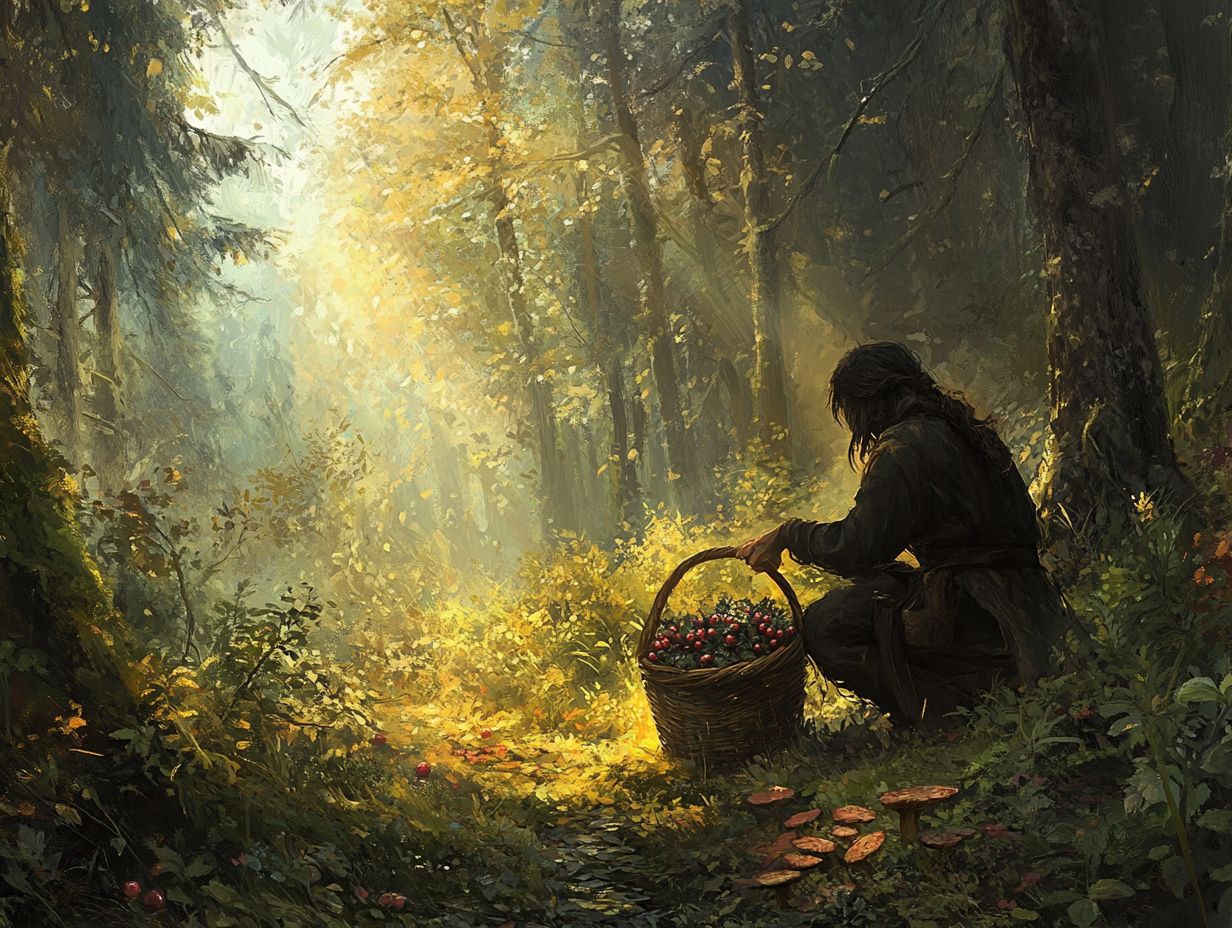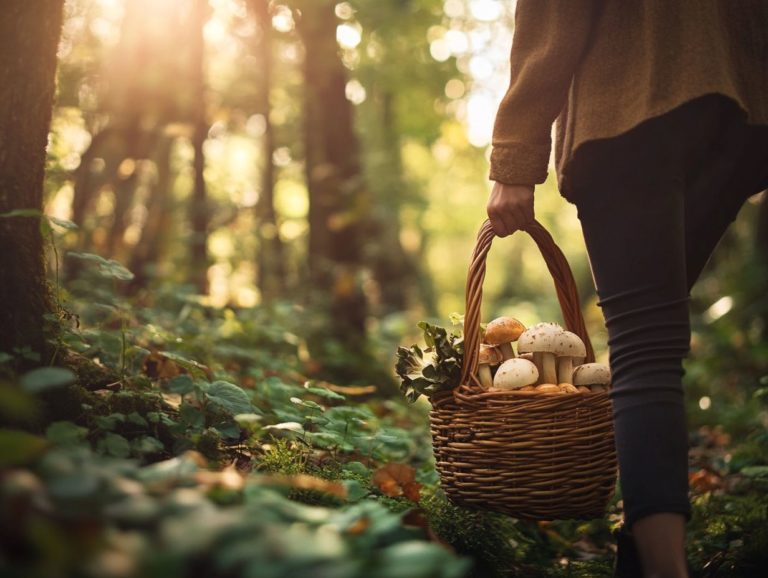Foraging in Protected Areas: What You Should Know
Protected areas are vital for preserving biodiversity. They play a critical role in maintaining natural habitats. As you embrace foraging to reconnect with nature, it s essential to understand the rules for collecting wild food and best practices for foraging in these protected spaces. This article delves into what protected areas are, the benefits of safeguarding these natural environments, and the regulations that govern foraging within them.
You ll also discover responsible practices, potential risks, and alternatives that support local agriculture. Get ready to explore how to enjoy nature responsibly!
Contents
- Key Takeaways:
- The Importance of Protected Areas
- Foraging in Protected Areas: What is Allowed?
- Rules and Regulations
- Permits and Permissions
- Responsible Foraging Practices
- Potential Risks of Foraging in Protected Areas
- Alternatives to Foraging in Protected Areas
- Frequently Asked Questions
- What is foraging in protected areas and why is it important to know about?
- Are all protected areas open for foraging?
- What are the potential consequences of foraging in protected areas without proper knowledge?
- Are there any specific guidelines for foraging in protected areas?
- What are some alternative options for foraging in protected areas?
- Is foraging allowed for commercial purposes in protected areas?
Key Takeaways:

Protected areas are essential for preserving natural habitats.
Foraging must be done responsibly and with the right permits.
Consider supporting local farmers instead of foraging.
The Importance of Protected Areas
Protected areas are crucial for conserving biodiversity and maintaining ecological balance. They ensure the survival of diverse plant species and wildlife while providing essential natural habitats.
These include National Parks and reserves specifically created to protect nature. They safeguard the unique flora and fauna that enrich our planet, supporting local ecosystems and fostering overall environmental health.
These areas also act as sanctuaries for endangered species. They offer a venue for sustainable practices that promote responsible exploration and education about our natural world, including herbal studies and the culinary arts.
What are Protected Areas?
Protected areas are designated regions specifically created to conserve the natural environment and its resources. They ensure the protection of biodiversity and vital natural processes.
These special zones can vary significantly, encompassing national parks, wildlife reserves, marine sanctuaries, and conservation easements. Each serves unique purposes and is governed by specific regulations.
The primary objectives of these locations extend far beyond mere preservation. They facilitate research, promote eco-friendly travel, and provide essential habitats for endangered species.
Adhering to strict conservation guidelines is paramount. These areas strive to mitigate human impacts like pollution and habitat destruction, all while fostering resilience within ecosystems. This holistic approach highlights the importance of maintaining the delicate balance of natural habitats, ultimately benefiting both the environment and society at large.
Benefits of Protecting Natural Habitats
Protecting natural habitats offers a multitude of benefits that go well beyond the immediate environment. By preserving biodiversity and enhancing local ecosystems, you contribute significantly to environmental protection.
These efforts also improve ecosystem services, such as clean air and water. They safeguard the historical significance of landscapes rich in cultural and ecological value.
Promoting biodiversity fosters resilience in natural systems, allowing them to better withstand environmental changes. Conservation initiatives enable local communities, equipping them with the resources and education necessary to engage in sustainable practices that enhance their livelihoods and the ecosystem.
Ultimately, by safeguarding these vital spaces, you create a harmonious relationship between nature and human societies. This ensures that future generations can enjoy invaluable rewards, including wild ingredients.
Foraging in Protected Areas: What is Allowed?
When foraging in protected areas, it’s essential to consider local regulations and adhere to ethical practices. Learning how to forage responsibly can help you embrace sustainable foraging principles such as mindful harvesting.
This thoughtful approach allows you to enjoy the bounty of wild foods. It also ensures the conservation of precious natural resources like wild greens and medicinal plants.
Rules and Regulations

When you venture into protected areas for foraging, following the right rules is crucial for a fantastic foraging adventure! These rules aim to preserve the environment and ensure the sustainability of local ecosystems, especially regarding invasive species.
Understanding the guidelines governing foraging activities is vital for anyone interested in gathering natural resources in these sensitive locations. Regulations specify which species you can harvest, how much you can take, and the appropriate seasons for foraging.
By adhering to these conservation guidelines, you help maintain the natural habitat and play a vital role in protecting biodiversity, which refers to the variety of plant and animal life in a particular habitat, in these areas.
Disregarding such rules can have harmful effects on fragile ecosystems. This underscores the importance of responsible and informed foraging practices that align with foraging ethics.
Permits and Permissions
Obtaining the necessary permits and permissions is crucial for responsible foraging in protected areas. This ensures that you adhere to ethical foraging practices as well as foraging ethics.
Start by researching the specific regulations in your area, as different regions may have unique requirements. You must submit detailed information about the foraging activities you plan to undertake, demonstrating your understanding of sustainable foraging principles.
Approval criteria typically consider factors such as the types of species you intend to forage, their ecological status, and the quantity you wish to harvest. By following these guidelines, you help preserve biodiversity and contribute to the overall health of ecosystems.
Cultivating a deep understanding of responsible practices enriches your foraging experience and supports the wider community and environment.
Responsible Foraging Practices
Embracing responsible foraging practices is essential for preserving the delicate balance of ecosystems and securing a sustainable supply of wild ingredients. By prioritizing mindful harvesting techniques, you contribute to the health of nature while enjoying the bounty it has to offer.
How to Minimize Impact on the Environment
You can minimize your impact on the environment while foraging by adopting sustainable practices. These practices reduce your environmental footprint and promote the health of local ecosystems.
This journey begins with a deep understanding of nature s delicate balance and the critical role of biodiversity. As a forager, prioritizing techniques like selective harvesting encourages the regrowth of plants while being mindful of the specific species you choose to target.
Opting for less common plants can help alleviate pressure on more vulnerable species, ensuring their survival in the wild. Responsible foraging means avoiding overharvesting and always leaving behind a portion of the plants to thrive.
By adhering to local guidelines and respecting seasonal growth patterns, you can revel in nature’s bounty while ensuring its future remains bright.
Potential Risks of Foraging in Protected Areas
Navigating the world of foraging in protected areas comes with its own set of potential pitfalls, especially concerning environmental and legal ramifications. It’s crucial to follow best practices for foraging responsibly. If you’re not well-versed in local regulations or inadvertently encounter invasive species, the consequences can be significant.
It’s essential to approach foraging with awareness and respect for the rules that govern these natural spaces, particularly those related to invasive plants.
Environmental and Legal Consequences

Foraging without following local rules can have serious environmental and legal consequences. This may harm local ecosystems and biodiversity, including invasive species.
Such actions can degrade fragile habitats, threaten native species, and disrupt the delicate ecological balance. If you violate these regulations, you could face significant legal repercussions, including hefty fines or even criminal charges.
Biopiracy refers to the unethical appropriation of indigenous knowledge and biological resources. It emphasizes the critical need for compliance to protect these invaluable assets. By respecting foraging laws, you not only safeguard the environment but also play a vital role in preserving cultural heritage. This ensures that future generations can responsibly benefit from the natural bounty.
Alternatives to Foraging in Protected Areas
Exploring alternatives to foraging in protected areas provides valuable opportunities to support local farmers and promote sustainable agriculture. Partnering with organic farmers is particularly beneficial.
In doing so, you foster a sense of community engagement that enriches everyone involved.
Supporting Local Farmers and Sustainable Agriculture
Supporting local farmers and embracing sustainable agriculture offers excellent alternatives to foraging. These efforts enhance food systems, including urban parks, while reducing your environmental footprint.
When you prioritize purchasing produce from nearby farms, you actively contribute to healthier ecosystems and vibrant communities. By supporting these practices, you help promote organic farming, which is vital for soil health and biodiversity!
Sourcing food locally often means enjoying fresher produce that retains more nutrients and flavor. This benefits both your health and your palate. The ripple effect of community engagement nurtures economic resilience, allowing funds to circulate within the local economy. Ultimately, this cultivates a more sustainable food system that nourishes both people and the planet.
Frequently Asked Questions
What is foraging in protected areas and why is it important to know about?
Foraging in protected areas refers to gathering wild plants, mushrooms, or other natural resources for personal use. It’s important to understand that protected areas are designated to conserve natural resources. Therefore, foraging may have restrictions or guidelines to prevent harm to these areas. This practice is part of a broader movement towards ethical foraging and understanding the historical significance of local flora.
Are all protected areas open for foraging?

No, not all protected areas allow foraging. Some have specific regulations or bans on foraging to maintain ecosystem balance and prevent over-harvesting. It’s crucial to check with the managing authority of the protected area before foraging to ensure it is allowed.
What are the potential consequences of foraging in protected areas without proper knowledge?
Foraging in protected areas without the right knowledge can disrupt the ecosystem and harm sensitive plants. To ensure you’re following the right practices, it’s important to understand foraging ethics, as you may also face fines if foraging is prohibited in that area.
Are there any specific guidelines for foraging in protected areas?
Yes, guidelines may limit the types and amounts of plants you can harvest. These rules protect nature and ensure our resources are available for future generations.
What are some alternative options for foraging in protected areas?
If foraging isn’t allowed, don t worry! You can still enjoy nature through guided walks and engaging workshops.
Is foraging allowed for commercial purposes in protected areas?
Generally, foraging for commercial purposes is prohibited in protected areas. These spaces are meant for conservation, not profit. If you want to forage commercially, ensure you have the right permits, or look for non-protected areas.






